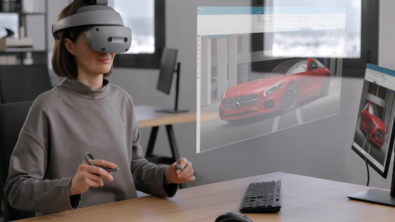New digitalization efforts empowering the future of mobility

Innovation in the automotive and transportation industry is at an all-time high. Spurred on by a combination of technological and societal trends, manufacturers of passenger cars, commercial vehicles, and off-highway equipment are pushing to develop cutting-edge features and functionalities for both current and future vehicles. Technologically, vehicle manufacturers are developing increasingly capable automated driving systems and connected vehicle features and investing in the creation of small yet powerful computational devices to enable these advanced features. From the societal perspective, there is a strong push for greener and more sustainable vehicles, now a critical thrust for the automotive and transportation industries. These efforts take several forms, including both the improvement of traditional combustion engine efficiency and emissions, and the development of new forms of vehicle propulsion to eliminate emissions and leverage alternative sources of energy.

All in all, vehicle manufacturers are faced with vastly more complex and challenging design processes for both current and future vehicles and growing market competition. Electrification, autonomy, and connectivity are driving requirements for more computing power, more electronic control units, and clever packaging of these many devices into the vehicle. Meanwhile, sustainability and efficiency efforts require optimizations in energy usage and the efficiency of the overall vehicle design. With complexity increasing, companies must determine how to continue to advance vehicle design, features, and technologies to realize the potential of the future of mobility, despite the challenge of growing complexity.
The only way to achieve all of this and deliver on aggressive schedules is to embrace digitalization and break down the boundaries that often exist between engineering domains and the stages of product development and manufacturing. Key to this approach is a comprehensive Digital Twin that captures every aspect of the vehicle design and production. Using such a Digital Twin, automotive manufacturers can connect engineering teams from across the electrical, electronic, software and mechanical domains. Now all these disciplines can work concurrently, quickly identifying and resolving issues, to quickly converge on an optimal system. This means automotive manufacturers will be able to design, verify and validate entire vehicle platforms, ensuring the highest standards of safety, reliability, and performance.
Such an approach enables companies to overcome the challenges of developing more complex and sustainable vehicles for the future of mobility. In the automotive and transportation industry, we are seeing some forward-thinking companies come to the forefront through digitalization efforts in vehicle design and simulation. One such company is Daimler Truck AG, the world’s largest Truck and Bus producer, with industry leading positions in Europe, North America and Asia, and with more than 35 main locations around the globe. Daimler Truck has adopted Siemens’ Simcenter™ STAR-CCM+™ software to develop next-generation, CO2-neutral vehicles. Simcenter, part of Siemens’ Xcelerator portfolio, will provide Daimler Truck with the leading-edge computational fluid dynamics (CFD) solution it needs to transform its CAE development process to a full digital twin-driven multiphysics environment.

Specifically, Daimler Truck plans to use these digital tools to improve aerodynamic performance, as well as explore and optimize innovative e-mobility propulsion and energy management systems, including battery cooling and hydrogen technology. The software will also help support legacy combustion engine and exhaust system design and associated CO2 reduction.
Advanced simulation solutions are a pillar in the construction of a comprehensive digital twin in the automotive and transportation industry. These solutions enable multi-attribute design studies that allow engineers to examine various tradeoffs, ensuring performance goals are met. Further optimizations are also possible through robust design space explorations that can help identify optimal solutions given the design constraints. Though powerful in their own right, these solutions are one part of a comprehensive, digital approach to product development in the automotive and transportation industries. Growing vehicle complexity and heightened competition are impacting all areas and domains of vehicle development, driving the need for digitalization across the enterprise. As companies like Daimler look to the future, they are realizing that digitalization offers the best path to achieving their goals.

Hyundai Motor Company and Kia Corporation (Hyundai and Kia) also recognized this reality and have entered into a technology partnership with Siemens to accelerate their digital transformation and a new future of mobility. Siemens, as the preferred bidder and strategic partner, will provide next generation engineering and product data management through NX™ software and the Teamcenter® portfolio from Siemens’ Xcelerator. As put by Albert Bierman, Head of R&D Division, Hyundai Motor Company, “Selecting NX software and the Teamcenter portfolio from Siemens’ Xcelerator portfolio for our core design and data management platforms will introduce a new working environment for our teams that will pave the way for a leap forward in future car development.”
Within this partnership, Hyundai and Kia and Siemens will collaborate to establish design methods and develop custom solutions that consider the lifecycle of all automobiles and associated processes and activities, such as production, purchasing and partners research and development. These activities will empower Hyundai and Kia as it undertakes a digital transformation journey with the goal of driving the future of mobility.
Digitalization is a necessary evolution for automotive companies as they confront a new era of vehicle design. In this new era, new approaches to vehicle development will become necessary. Key to these new approaches will be the encouragement of cross-domain collaboration, data coherency throughout the product lifecycle, and the ability to capture and analyze data from testing and the field, creating a closed-loop. Through our customers, we are already seeing the future of the automotive and transportation industries taking shape today. These companies are embracing the power of digitalization and the digital twin to energize their pursuit of the future of mobility in both commercial and consumer sectors. As these companies fully leverage the capabilities of their new digital working environments, we will have the pleasure of witnessing a new age of greener, smarter, and more capable vehicles on our roads.


